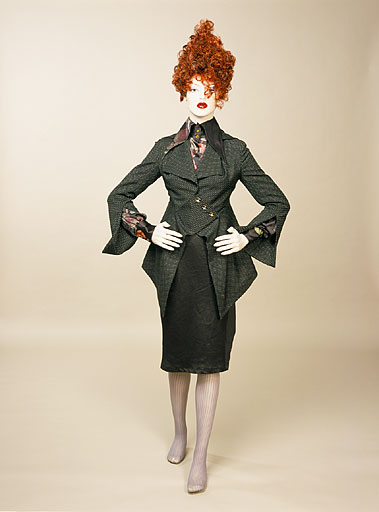suit
Summary
Jacket : "Worthmore" black mohair/wool mix woven with a white flecked parallel stripe. Complex construction, with fronts dipping to points either side cf. Wide turned down collar; very wide separate revers; front opening, fastening diagonally to the left with 3 enamelled buttons (showing the orb and ring motif). Long sleeves without cuffs, but with deep faced slit on the inner seam. CB seam with deep inverted box pleat; side seams from under shoulder curving round side to point at fronts and then moving diagonally up to meet CF at the base of the revers. Each back panel cut as one piece with front skirt panels. Side pockets on the hips, tacked closed. Fronts faced with self fabric; upper bodice and sides lined with pink acetate. Skirt : black linen with back draperies tying up into an asymetrical bustle. Fastening to left side with a zip and amber button with Westwood logo. Inner and outer tie tapes forming a bustle (instructions attached inside). Unlined. Blouse : "Hals"; black silk satin printed with full blown red and yellow roses and green foliage. Shirt style with vast pointed collar and triple buttons cf neck. Fastening full length cf with 5 extra yellow buttons. Long sleeves with double button cuffs. Cut with side seams and fitted with vertical darts either side cf and cb. Curved tails, longer at back. Unlined.
Display Label
Vivienne Westwood's clever use of historical references and her unwavering anti-establishment attitude make her one of Britain's most original and celebrated fashion designers. Typically, she here combines an eighteenth century style print with a classic man's shirt. Originally used as furnishing fabrics in France, these prints known as 'Toules de Jouy' generally featured monochrome pastoral scenes printed on a pale ground. Born in 1941, and very much a self-taught designer, Westwood began her career in the late 1960s on London's King's Road, where she and partner Malcolm McLaren sold their designs in a series of eye-grabbing shops, called respectively, Let It Rock (1970), Too Fast To Live, Too Young To Die (1972), Sex (1974), Seditionaries (1976), and World's End (1981). Westwood's collaboration with McLaren during the 1970s punk movement brought the two of them national notoriety, as their bondage trousers and gritty t-shirt designs promoted their subversive image. Since 1982, Vivienne Westwood has shown her catwalk collections under her own name. Her innovative haute couture and ready-to-wear designs demonstrate a unique talent for turning tradition on its head, and her use of traditional fabrics, techniques and historical imagery is balanced with expert craftsmanship. She has become the "grande dame" of British couture, as symbolised by the 2004 retrospective exhibition at the Victoria and Albert Museum.
Object Name
suit
Creators Name
Date Created
1994
Dimensions
blouse (blouse : L (back) : 31 in):
jacket (jacket : L (back) : 26 in):
accession number
1994.90/3
Collection Group
Place of creation
London
Medium
Legal
© Manchester Art Gallery


